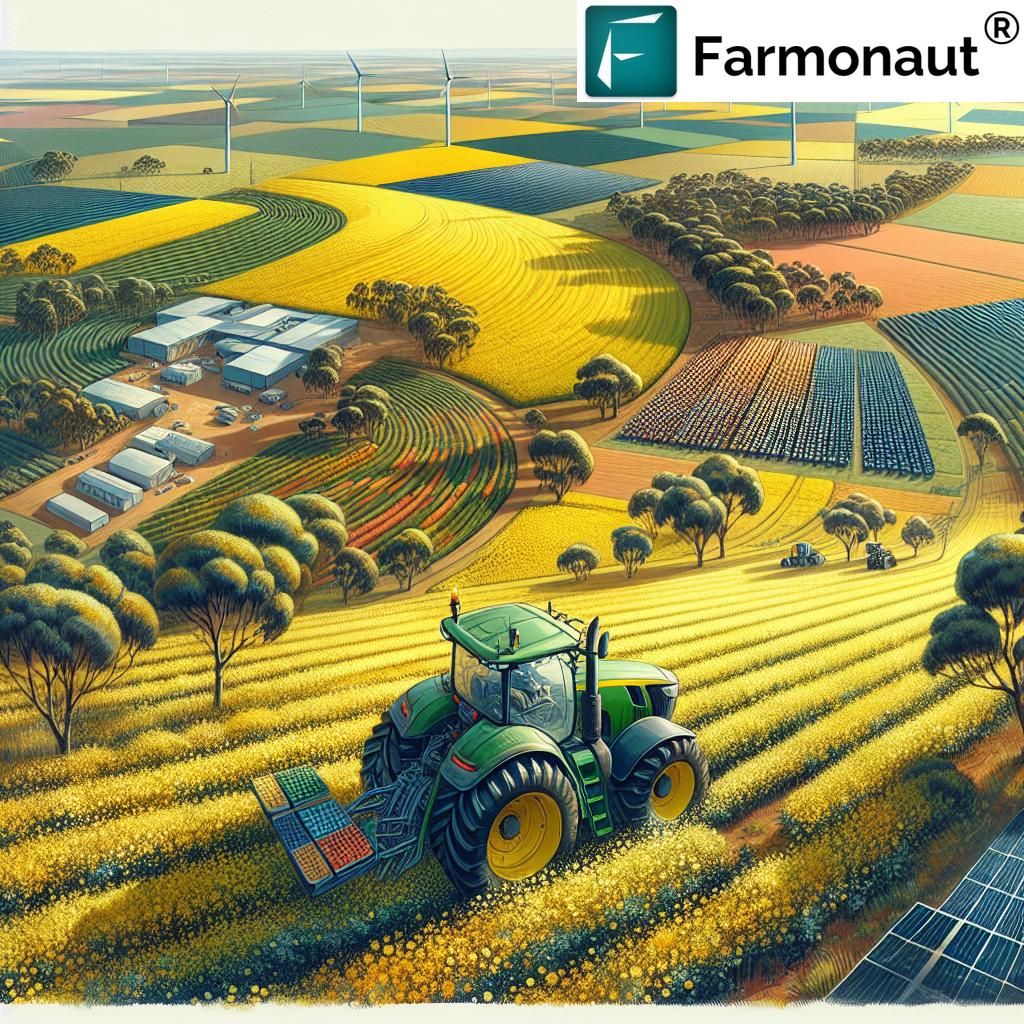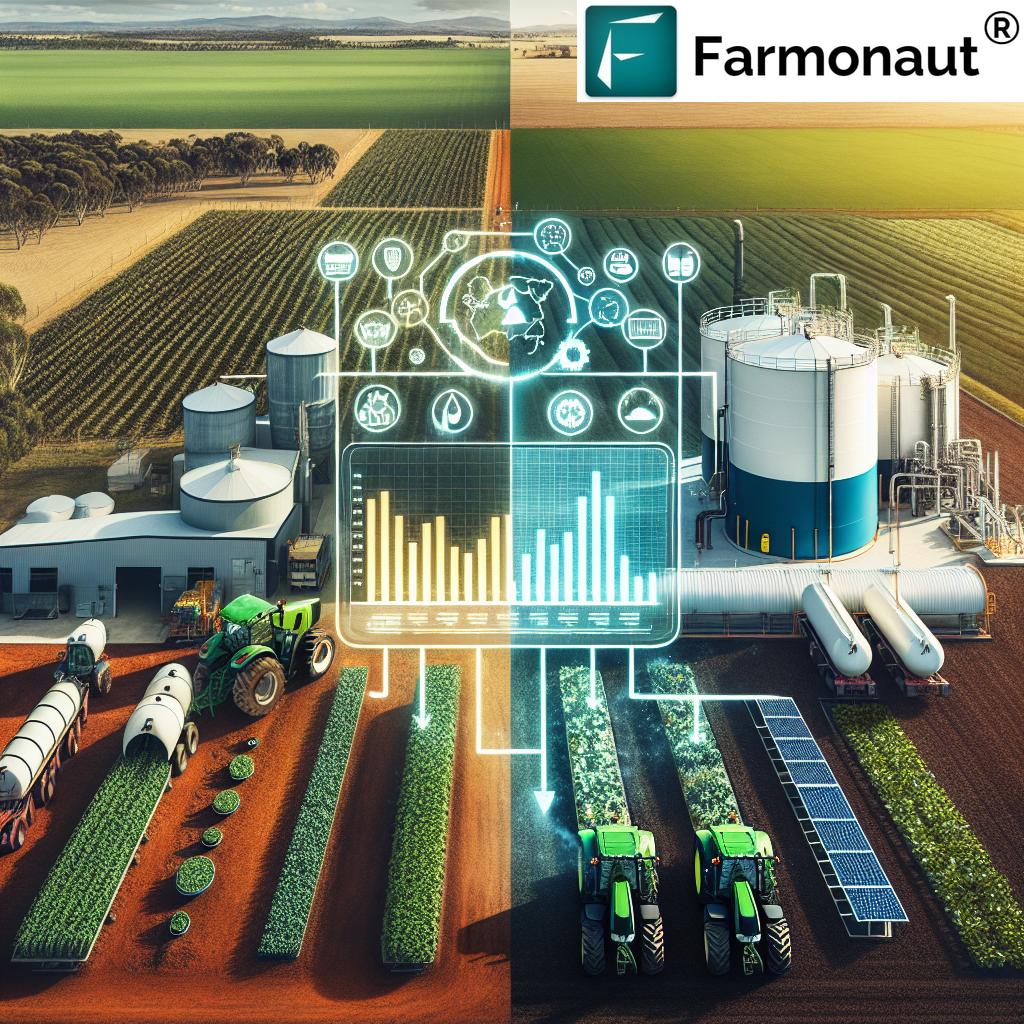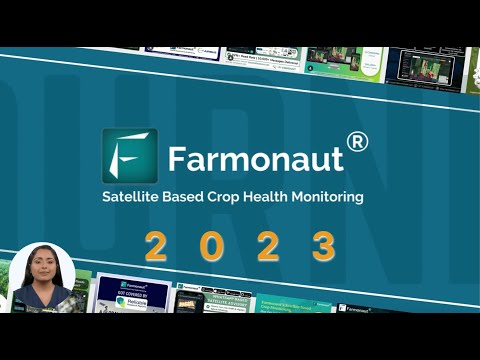Sustainable Agriculture in NSW: Driving Economic Growth Through Renewable Fuels and Oilseed Crops
“NSW’s oilseed crop production could potentially reduce agricultural carbon emissions by up to 20% through renewable fuel adoption.”
In the heart of Australia’s agricultural landscape, a green revolution is taking root. As we navigate the challenges of climate change and economic sustainability, New South Wales (NSW) is poised to lead the charge in transforming the agricultural sector through innovative and sustainable practices. At the forefront of this transformation is the burgeoning potential of renewable fuels and oilseed crops, which promise not only to decarbonize our agriculture but also to fuel significant economic growth in our regional areas.
In this comprehensive exploration, we at Farmonaut will delve into the exciting opportunities that lie ahead for growers in NSW and across the nation. We’ll examine how the integration of sustainable agriculture practices, particularly in the realm of renewable energy in farming, can create a ripple effect of positive change throughout our communities and beyond.
The Promise of Oilseed Crops in Sustainable Fuel Production
Oilseed crops have emerged as a beacon of hope in our quest for sustainable fuel feedstock. These versatile plants not only provide essential food products but also hold the key to unlocking a new era of biofuel production. Let’s explore how crops like canola, sunflower, and safflower are revolutionizing the renewable fuel landscape in NSW:
- Biodiesel Production: Oilseed crops are excellent sources for biodiesel, a renewable alternative to traditional diesel fuel. The high oil content of these crops makes them ideal candidates for efficient fuel conversion.
- Aviation Fuel Potential: As the aviation industry seeks to reduce its carbon footprint, oilseed-derived sustainable aviation fuels (SAF) are gaining traction. NSW farmers are well-positioned to capitalize on this growing market.
- Low Carbon Agriculture: By cultivating oilseed crops for fuel production, farmers contribute directly to lowering the carbon intensity of both agriculture and transportation sectors.
The integration of these crops into our agricultural landscape not only diversifies farm income but also aligns perfectly with our national goals for reducing greenhouse gas emissions and promoting sustainable development.
Economic Growth Through Sustainable Agriculture
The shift towards sustainable agriculture and renewable fuel production is not just an environmental imperative; it’s an economic opportunity waiting to be seized. Here’s how this transition is driving economic growth in NSW and beyond:
- Job Creation: The development of a robust renewable fuel industry creates new employment opportunities across the value chain, from farming to processing and distribution.
- Rural Revitalization: By providing new income streams for farmers and attracting investment in regional areas, sustainable fuel production helps to reinvigorate rural economies.
- Export Potential: As global demand for sustainable fuels grows, NSW is well-positioned to become a significant exporter, bolstering our national economy.
To fully realize these economic benefits, it’s crucial that we adopt a holistic approach to agricultural economic growth, one that balances profitability with sustainability.
Decarbonizing Agriculture: A Path to Sustainability
Decarbonizing agriculture is not just about reducing emissions; it’s about reimagining our entire approach to farming. Here are key strategies that NSW farmers are implementing to achieve this goal:
- Precision Agriculture: Utilizing advanced technologies like those offered by Farmonaut’s satellite-based farm management solutions to optimize resource use and minimize waste.
- Crop Rotation: Implementing smart crop rotation practices that include oilseed crops to improve soil health and reduce the need for synthetic inputs.
- Renewable Energy Integration: Adopting on-farm renewable energy solutions, such as solar and wind power, to reduce reliance on fossil fuels.
These practices not only contribute to lowering the carbon footprint of agriculture but also enhance the overall resilience and productivity of farming operations.

The Role of Policy in Shaping Sustainable Agriculture
For the sustainable agriculture revolution to truly take root, supportive policies at both state and national levels are essential. Here’s how policy-making is shaping the future of agriculture in Australia:
- Renewable Fuel Mandates: Implementing and expanding mandates for the use of renewable fuels in transportation and industry.
- Research and Development Funding: Increasing investment in R&D to improve crop yields, processing efficiency, and fuel performance.
- Tax Incentives: Offering tax breaks and subsidies to farmers and businesses that invest in sustainable practices and renewable fuel production.
These policy initiatives are crucial in creating a favorable environment for the growth of sustainable agriculture and the renewable fuel industry in NSW and across Australia.
Enhancing Domestic Production of Renewable Energy in Farming
To truly revolutionize our agricultural sector, we must focus on enhancing the domestic production of renewable energy within our farming communities. This approach not only reduces our carbon footprint but also creates a more resilient and self-sufficient agricultural industry. Here are key strategies to boost renewable energy production on farms:
- On-Farm Bioenergy: Encouraging the development of small-scale bioenergy plants that can convert agricultural waste into usable energy.
- Solar and Wind Integration: Promoting the installation of solar panels and wind turbines on agricultural land, allowing farmers to generate their own clean energy.
- Energy Storage Solutions: Investing in battery storage technologies to ensure a consistent energy supply, even when renewable sources are intermittent.
By embracing these technologies, NSW farmers can reduce their operational costs, increase energy independence, and contribute to the broader goal of decarbonizing agriculture.
Innovative Farming Techniques for Sustainable Fuel Feedstock
To maximize the potential of oilseed crops as sustainable fuel feedstock, farmers in NSW are adopting innovative techniques that boost yields while minimizing environmental impact. Let’s explore some of these cutting-edge practices:
- Precision Planting: Utilizing GPS-guided machinery to optimize seed placement and reduce waste.
- Conservation Tillage: Implementing no-till or reduced tillage methods to preserve soil structure and reduce carbon emissions.
- Smart Irrigation: Employing sensor-based irrigation systems to deliver water precisely when and where it’s needed, conserving this precious resource.
These techniques not only enhance the production of oilseed crops but also contribute to the overall sustainability of agricultural operations.
“Sustainable agriculture practices in Australia could contribute to a 15% increase in regional economic growth over the next decade.”
Regional Agricultural Opportunities in NSW
The shift towards sustainable agriculture and renewable fuel production presents a wealth of opportunities for regional areas in NSW. Here’s how different regions can benefit:
- Central West: With its vast agricultural lands, this region is ideal for large-scale oilseed production and biofuel processing facilities.
- Riverina: Known for its diverse crop production, the Riverina can become a hub for integrated food and fuel systems.
- New England: This region’s cooler climate is suitable for certain oilseed varieties, offering unique opportunities for specialized fuel feedstock production.
By capitalizing on these regional strengths, NSW can create a robust and diversified renewable fuel industry that supports local economies across the state.

The Intersection of Sustainable Agriculture and Profitable Ventures
One of the most exciting aspects of the sustainable agriculture revolution is its potential to create profitable ventures that align with environmental goals. Here’s how farmers and agribusinesses can capitalize on this intersection:
- Value-Added Products: Developing high-value products from oilseed crops, such as specialty oils or protein-rich animal feed.
- Carbon Credit Markets: Participating in carbon trading schemes by implementing practices that sequester carbon in the soil.
- Agritourism: Showcasing sustainable farming practices and renewable energy production to attract eco-conscious visitors.
These innovative approaches demonstrate that profitability and sustainability can go hand in hand, creating a win-win situation for farmers and the environment.
Farmonaut’s Role in Advancing Sustainable Agriculture
At Farmonaut, we’re committed to supporting the transition to sustainable agriculture through our cutting-edge technology solutions. Our satellite-based farm management platform offers invaluable tools for farmers embracing sustainable practices:
- Crop Health Monitoring: Real-time satellite imagery helps farmers optimize resource use and detect issues early, reducing waste and improving yields.
- AI-Powered Insights: Our Jeevn AI advisory system provides personalized recommendations for sustainable crop management.
- Carbon Footprint Tracking: We offer tools to help farmers monitor and reduce their environmental impact, supporting efforts to decarbonize agriculture.
By leveraging these technologies, farmers can make data-driven decisions that enhance both sustainability and profitability. To learn more about how Farmonaut can support your sustainable farming journey, visit our web app or download our mobile app for Android or iOS.
Comparison of Oilseed Crops for Renewable Fuel Production in NSW
| Crop Name | Estimated Yield (tonnes/hectare) | Oil Content (%) | Potential Biodiesel Production (litres/hectare) | Carbon Footprint (CO2 equivalent/hectare) | Water Requirements (mm/growing season) | Soil Suitability | Economic Potential (estimated revenue/hectare) |
|---|---|---|---|---|---|---|---|
| Canola | 2.5 – 3.5 | 38 – 45 | 1000 – 1400 | 1.2 – 1.5 | 450 – 750 | Well-drained, loamy | $1500 – $2000 |
| Sunflower | 1.5 – 2.5 | 40 – 50 | 700 – 1100 | 0.9 – 1.2 | 600 – 1000 | Deep, fertile | $1200 – $1800 |
| Safflower | 1.0 – 2.0 | 35 – 45 | 400 – 800 | 0.7 – 1.0 | 300 – 600 | Drought-tolerant, deep-rooted | $800 – $1400 |
This table provides a comprehensive overview of the economic and environmental aspects of different oilseed crops suitable for renewable fuel production in NSW. It offers valuable insights for farmers considering diversifying into sustainable fuel feedstock production.
The Future of Sustainable Agriculture in Australia
As we look to the future, the potential for sustainable agriculture in Australia, particularly in NSW, is boundless. By embracing renewable fuels, innovative farming practices, and cutting-edge technologies, we can create a more resilient, profitable, and environmentally friendly agricultural sector. Here are some key trends and predictions:
- Increased Adoption of Precision Agriculture: Technologies like Farmonaut’s satellite-based solutions will become standard tools for efficient farm management.
- Expansion of Renewable Fuel Production: We anticipate a significant increase in the production of biodiesel and sustainable aviation fuels from oilseed crops.
- Integration of Artificial Intelligence: AI-driven decision-making tools will play a crucial role in optimizing farm operations and resource use.
- Growth in Carbon Farming: More farmers will participate in carbon sequestration initiatives, contributing to national emissions reduction goals.
These developments promise to position Australia as a global leader in sustainable agriculture and renewable energy production.
Conclusion: A Greener, More Prosperous Agricultural Future
The path towards a sustainable and economically vibrant agricultural sector in NSW is clear. By harnessing the power of renewable fuels, embracing innovative farming techniques, and leveraging cutting-edge technologies, we can create a future where environmental stewardship and economic growth go hand in hand.
As we’ve explored throughout this article, the opportunities for growers in NSW and across Australia are immense. From the production of sustainable fuel feedstock to the adoption of low carbon agriculture practices, every step towards sustainability is a step towards a more resilient and profitable future.
At Farmonaut, we’re committed to supporting this transition by providing farmers with the tools and insights they need to thrive in this new era of sustainable agriculture. Together, we can build a greener, more prosperous future for NSW and set an example for the world to follow.
To learn more about how Farmonaut can support your journey towards sustainable agriculture, explore our API or check out our API Developer Docs.
FAQ Section
- What are the main benefits of growing oilseed crops for renewable fuel production?
Growing oilseed crops for renewable fuel production offers multiple benefits, including diversification of farm income, contribution to reducing carbon emissions, and supporting the development of a sustainable fuel industry. - How can farmers in NSW transition to more sustainable agricultural practices?
Farmers can transition by adopting precision agriculture techniques, implementing crop rotation with oilseed crops, using renewable energy on-farm, and leveraging technologies like Farmonaut’s satellite-based farm management solutions. - What role does government policy play in promoting sustainable agriculture?
Government policy is crucial in providing incentives for sustainable practices, setting renewable fuel mandates, funding research and development, and creating a supportive regulatory environment for the industry. - How can regional areas in NSW benefit from the shift to sustainable agriculture?
Regional areas can benefit through job creation in renewable fuel production, increased investment in agricultural infrastructure, and the development of new, value-added industries related to sustainable farming practices. - What technologies are available to help farmers improve sustainability and profitability?
Technologies such as satellite imagery, AI-powered advisory systems, precision planting equipment, and renewable energy solutions are available to help farmers enhance both sustainability and profitability.



